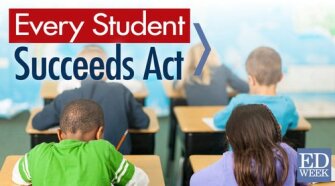
You’d be forgiven if you said you’ve thought less about the Every Student Succeeds Act during the past several weeks. But aside from the ESSA waivers U.S. Secretary of Education Betsy DeVos has provided states to help them deal with the pandemic, are there other ways educators could be taking advantage of the law itself to help students in need?
The answer is yes, says Ashley Jochim, a senior research analyst at the Center on Reinventing Public Education in Seattle. In a piece on the organization’s website, Jochim lays out three ways states can take advantage of ESSA to maximize what they can provide during the pandemic, which has shut down most states’ in-person classes for the rest of the school year. One theme in her piece? There’s millions of dollars states can use outside of the traditional federal funding formulas to help schools address the coronavirus.
1) Take advantage of Direct Student Services
This is a part of ESSA that several organizations have pushed for ever since ESSA became law, but it hasn’t proven particularly popular among states. Under Direct Student Services, states can set aside up to 3 percent of their Title I money for disadvantaged students to provide options such as course choice, online tutoring, credit-recovery classes, and similar programs—providers can be public as well as private.
We’ve written extensively about Direct Student Services and about how states like Louisiana and New Mexico have taken advantage of it; it doesn’t provide school choice the way vouchers and tax credits do, but it’s a form of choice. So could this kind of flexibility for students prove particularly useful to students in the fallout from the coronavirus? Jochim thinks it will, writing that, “States and districts could use the online course option to give low-income families access to high-quality remote learning options ... now, over the summer, or in the fall, should future school closures be required.”
In an interview, Jochim noted that this strategy can rely on a lot of things districts are in a position to provide, and not “privatization.”
“This crisis has opened up new possibilities for people who [normally] may have disagreed with each other. And now people are like, ‘We need to come together and solve these challenges facing our students in new ways,’” she said.
2) All those resources for tests? Use them elsewhere
Every state has been allowed to nix federally mandated annual exams in reading and math, and states are canceling other tests as well. So what to do with the money and contracts that were already tied into those testing regimens?
Jochim writes that “states should focus on working with testing vendors and existing contracts and assessment systems to support diagnostic testing for every student” to see how the pandemic has impacted their academic needs.
I asked Jochim how difficult she thinks those negotiations might be, and how difficult it might be to point these systems and resources in a new direction. She said she hasn’t seen an example yet where a state and a testing company have altered their contract to address new needs stemming from the virus. And she acknowledged that “procurement is difficult territory in public systems, including public education.”
However, Jochim also said, “I think that there is openness in the private sector right now to be responsive to emerging needs that maybe they wouldn’t be in the absence of a crisis. In beginning, people thought this was short term.”
3) Use successful strategies for related challenges
There’s another provision in ESSA in which states are required to set aside 7 percent of their Title I aid for school improvement purposes (as opposed to the optional 3 percent set-aside for direct student services).
While the mass school closures caused by the virus are unprecedented, Jochim says, states should focus on what has worked to address problems caused by summer-learning loss and high student mobility. “This should include building out a comprehensive list of evidence-based strategies for remediating gaps in learning that districts can tap,” she writes.
In the interview, Jochim said that “high-dosage” tutoring of the sort used in Lawrence, Mass., is one example of a strategy that could fit the bill in these circumstances.
“I think what’s really important is that districts not be forced to reinvent the wheel,” she said.
